ABSTRACT
In the late 1960s, the first Tehran Master Plan (TMP) was envisioned by a constellation of local and foreign experts. The TMP, which has been extensively studied, is usually credited to big-name planner and architect Victor Gruen. Scholars have neglected the contributions of local professionals in shaping the plan. Many depict the TMP as the product of Cold War geopolitics and a scheme directly exported to Tehran to facilitate top-down modernization promoted by the pro-American Shah. This popular narrative flattens the complexity of transnational urbanism and obscures the transformative role performed by locals therein. Through archival studies and conducting interviews with local planners involved in the TMP, this paper aims to discover the complex nexus between national and international actors and unravel how Iranian planners collaborated with foreign counterparts to negotiate Tehran’s urban problems and project the future of the city. This paper argues that Gruen served as a figurehead to validate the formation of the first planning document for Tehran by young local planners who had their own planning agenda. The conclusion argues that the transnationalism of planning practices in Iran grew out of an attempt to institutionalize a modern planning regime compatible with global standards while nurturing local experts.
Introduction
In 1965, the Plan Organization, Iran’s central planning institution, commissioned the first Tehran Master Plan (TMP).Footnote1 The Plan Organization invited the Iranian architectural firm Abdolaziz Farmanfarmaian Associates (AFFA) and the American planning and architectural firm Victor Gruen Associates to envision the plan. Gruen considered himself an urban surgeon and a specialist in ‘urban heart disease’.Footnote2 At the time of the Plan Organization’s invitation, in the mid-1960s, his gigantic shopping centres and downtown renovation projects made him ‘a media celebrity’.Footnote3 Gruen’s notion of shopping centres heavily influenced his concept of urban model for future cities. He elaborated his ideal metropolis in his 1964 book, The Heart of Our Cities, and named it ‘A Cellular Metropolis of Tomorrow’. Gruen and Farmanfarmaian established a joint venture office in Tehran and Iranian planner Fereydoon Ghaffari, who worked in Gruen’s office, was appointed the TMP’s managing director.
Scholars of Iranian modern planning place the history of Iran’s modern planning in the sphere of the Cold War, viewing the TMP as a one-way imposition of urban planning ideas to the capital. The existing literature has typically approached the TMP in terms of how, in the political context of the Cold War, Gruen’s urban model was directly superimposed on the capital.Footnote4 Despite the diversity of their approaches, these studies tend to depict Gruen as an omnipotent protagonist who exercised personal control over the planning of the entire city. Rosemary Wakeman regards the TMP as a primary example of Gruen’s futurist urban vision.Footnote5 Offering a brief review of the political atmosphere of Iran in the 1960s, Wakeman stresses that the TMP was undertaken with the direct assistance of the United States. She describes the TMP as ‘an all-out American-style modernization of Iran and the exporting of utopian urban visions directly to Tehran’.Footnote6 Wakeman maintains that the TMP is a good example of ‘how allegiance to urbanistic fantasy could be aligned with global geopolitics’.Footnote7 This quote from Jeffrey Hardwick’s monograph on Victor Gruen can also echoe the common narrative in the existing literature:
Gruen happened upon one client who perhaps could realize his modernizing dreams for reshaping a city. […] He was hired by the Shah of Iran to re-design the capital city Tehran. […] The Shah’s pursuit of efficiency and Westernization led him to the United States for technical and economic support. […] The Shah called on Gruen. Gruen eagerly began re-planning Tehran. The Shah was the client that Gruen had long wanted. In this case a dictator capable of giving Gruen the land, power, and means to control every facet of the environment.Footnote8
The objective of this paper is not to underrate the influence of Gruen and his principles of urbanism upon the TMP. Rather, it proposes a shift in the focus from a big-name planner to anonymous local protagonists and ‘their capacity to react, resist, contest and adapt’.Footnote12 The paper argues local planners played leading roles in conception, formation and realization of the TMP, who have largely remained invisible in Iranian urban and planning history. By dismantling the dichotomy between local and foreign actors, this paper aims to unravel the interplay between multiple actors and thus depict a more realistic image of transnational urbanism at work from the moment of commissioning of the TMP, to its formulation, realization, and eventually the rising criticism of the plan. Data for this study were collected through archival sources and through conducting interviews with two Iranian planners involved in the TMP, Dariush Borbor and Ferydoon Rassouli. Moreover, the recently published autobiography of the TMP’s managing director Fereydoon Ghaffari, My Journey: From Anzali to Los Angeles, was of great significance in shaping the argument of this study.
The paper is structured in four sections. Starting with a brief review of the institutionalization of modern planning regime in Iran, the first section examines how the 1960s national policies regarding the development of architectural and urban projects attracted not only foreign-trained Iranian architects and planners to the country, but also international experts to collaborate with them and supervise emerging urban plans. By focusing on the TMP and its internationalization, the second section traces the commission of the plan and offers insight into the largely unknown selection of the planning team and the invitation of Gruen’s firm. Particularly, this section discovers priorities and motivations of local actors in forming a joint venture. The third section reconstructs extensive transnational dialogues between local planners and their foreign counterparts. Moreover, by examining the conception of the TMP and its underlying principles, this section reveals the complex process in which Gruen’s visionary urban model evolved with the input of local planners. The final section examines the further development and implementation of the plan in the 1970s and studies the elaboration of two new satellite towns as parts of the TMP’s recommendations where local planners became the main leaders of the plan without any supervision by foreign experts. Moreover, this section debates how in the late 1970s a modern transnational planning regime emerged, that became a subject of criticism by local planners.
Transnational building of a modern planning regime in Iran
In 1962, in the midst of the Cold War and under the direct influence of John. F. Kennedy’s presidency, Mohammad Reza Shah launched his White Revolution, generally known as a top-down modernization project ().Footnote13 Due to rising socio-political unrest in Iran, Kennedy pressured the Shah to initiate reforms.Footnote14 The Kennedy administration hoped that the White Revolution reforms could prevent Communist-inspired revolution in Iran. The administration, therefore, funnelled money to Iran to stabilize the US position in the Cold War contest. However, for the Shah, the key ambition of the White Revolution was to make Iran in general and Tehran in particular a ‘showcase of modernization’ in the Middle East region.Footnote15 The White Revolution, therefore, embraced fundamental social and economic reforms in which land reform was among the most influential.Footnote16 Many of the White Revolution reforms targeted traditional ruling classes: ulema (traditional religious leaders) and their allies, the bazaaris (traditional merchants), who were also among big landowners, and enjoyed a great deal of control over economic and social affairs in the country.Footnote17 Their politico-economic power presented a considerable barrier to the Shah’s modernization project.Footnote18 Ulema and bazaaris saw modernization and industrialization as threats ‘to the traditional Islamic way of life’ and therefore ‘to their economic and social supremacy’.Footnote19 Thus, they became the main opponents of the White Revolution and mobilized mass support against the Shah.Footnote20
Figure 1. President John F. Kennedy meets with Mohammad Reza Pahlavi at the White House, 1962.
Source: Robert Knudsen. White House Photographs. John F. Kennedy Presidential Library and Museum, Boston.
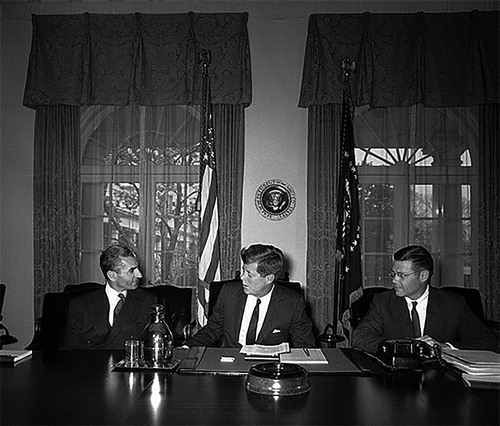
To accelerate modernization and make it compatible with global standards, the government-sponsored Plan Organization aimed at nurturing a generation of local experts through internationalization of development projects.Footnote21 The Plan Organization served as the main institution to realize the king’s aspirations for the country.Footnote22 To improve its functionality, in 1954 the Shah personally appointed the Iranian economist Abolhasan Ebtehaj as the head of the Plan Organization.Footnote23 The former board member of Iran’s National Bank and pioneer of the concept of economic planning in Iran, Ebtehaj was an internationally well-known figure.Footnote24 From 1954 to 1959, he played a central role in a fundamental restructuring of the Plan Organization. Ebtehaj initiated a new phase in Iranian planning by laying a foundation for close collaboration with foreign experts and advisors, who were expected to transfer their knowledge and experience to Iranian counterparts.Footnote25 For Ebtehaj, collaborating with foreign experts was a way to nurture a generation of local experts.Footnote26
In the early 1960s, the Plan Organization passed a rule that compelled Iranian firms to collaborate with Western companies – with a minimum share of 50 percent for local firms.Footnote27 This rule attracted many foreign-trained Iranian architects and planners who enthusiastically returned to the country and registered their architecture and planning firms with the Plan Organization.Footnote28 As a result, in the early 1960s, the number of registered Iranian consulting firms increased remarkably.Footnote29 Foreign-trained Iranian professionals played a significant part in channelling well-known architects and planners from their countries of study towards Iran. The growing economic condition and the fast-paced modernization of the country made Iran a favourable destination for foreign firms. According to Iranian scholar and urban planner Bahram Farivar Sadri, the inception of collaboration between Iranian and foreign firms became a turning point in modern planning practices in Iran.Footnote30
Directed by foreign-trained Iranian planners, a modern planning regime was conceived in Iran in which Dariush Borbor, British-trained urban planner, played a prominent role therein.Footnote31 The birth of Iranian modern planning system can be dated to the establishment of the Ministry of Housing and Urban Development (MHUD) in 1964 and of the High Council of Architecture and Urban Planning (HCAUP) in 1966 with the support of the Plan Organization.Footnote32 The MHUD was responsible for ‘programs and projects related to urban planning, land use, urban water supply and sanitation, new development and housing’.Footnote33 Soon after its establishment, the MHUD commissioned 14 master plans for major cities in Iran.Footnote34 In order to formulate overall urban planning policies and approval strategies for the upcoming master plans, in 1966 the HCAUP was formed.Footnote35 The council consisted of the twelve ministers who were serving at the time with French-trained Iranian architect Naser Badi, as director; he was the former head of the planning department in the Tehran Municipality (). The Plan Organization became responsible for administering the contracts of the master plans and the HCAUP took charge of technical matters related to the plans.Footnote36
Figure 2. The Shah and Queen Farah visit the High Council of Urban Planning and Architecture, in 1966. Amir-Abbas Hoveyda (Prime Minister), Naser Badi (Director of the Council), and Dariush Borbor (Urban Planning Consultant) are also present in the photo.
Source: Dariush Borbor.
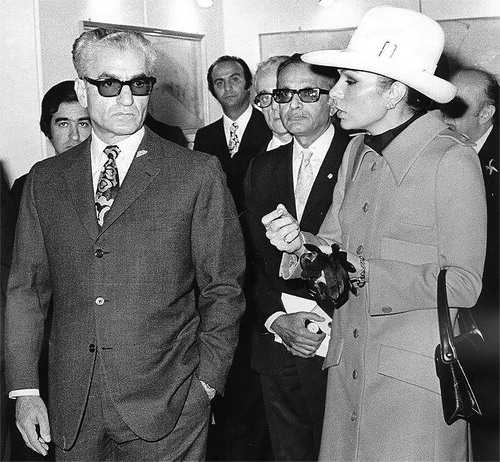
To assure that joint-ventures of national and international planners with a variety of training backgrounds would respect the local context of Iranian cities, the HCAUP required the preparation of two different but interrelated phases for each master plan.Footnote37 The first phase was dedicated to general studies of the city, including its social, economic and physical features.Footnote38 The second phase called ‘Detailed Plan’ introduced the urban plan with detailed recommendations for its realization.Footnote39
Internationalizing the first Tehran master plan: from consortium to joint venture
The formation of the TMP and the intricacy of selecting eligible and qualified planners to conceive the most prominent planning document for the capital city of Tehran indicate the emerging role of Iranian professionals in a newly born modern planning system. In 1965, the first TMP was commissioned by the deputy director of the Plan Organization, Mohammad Ali Safi Asfia.Footnote40 The Plan Organization first insisted on the leadership of foreign-trained Iranian planners who had recently founded their own architecture and planning firms in the country.Footnote41 Since none of them was experienced enough to guarantee the development of the project, the Plan Organization appointed four newly established local planning and architectural firms to form a consortium.Footnote42 The consortium consisted of Dariuish Borbor, British-trained urban planner; Ali Adibi, American-trained civil engineer; Farokh Hirbod, American-trained urban planner; and AmirAli Sardar Afkhami, French-trained architect.Footnote43
While the appointed Iranian planners battled for their own position and supremacy in the planning process, they organized Gruen’s invitation to help reinforcing the formation of the consortium. Hirbod, who had worked for Victor Gruen Associates, proposed inviting Gruen to collaborate with the locals.Footnote44 Gruen immediately discussed the issue with Fereydoon Ghaffari, an Iranian architect who was working at Victor Gruen Associates since his graduation in 1955. Ghaffari studied architecture at the University of Southern California; however, since the beginning of his professional career, he had been involved in urban planning projects in the Gruen’s office.Footnote45 Ghaffari travelled to Tehran to meet with the Iranian architects of the consortium. Local planners offered Victor Gruen Associates to be ‘the sub-consultant of the consortium’, but Gruen refused to participate in the project as a sub-consultant.Footnote46 Ghaffari explained:
[…] the meeting with the architects was not what I expected. Instead of trying to define the process of hiring a foreign consultant and preparing the master plan – as suggested by the government – the architects were arguing, each over the position of his firm within the consortium. Each architect wanted to be the head of the consortium group.Footnote47
After the dismantling of the consortium of Iranian planners, the selected firm of Farmanfarmaian had to be partnered with an expert foreign planner, since he had neither any experience in urban planning nor any urban planners on his team.Footnote52 Ghaffari played an instrumental role in the awarding of the contract to Victor Gruen Associates. With the knowledge that Farmanfarmaian was in search of a foreign partner, Ghaffari contacted him and proposed Victor Gruen Associates as the partner. According to Ghaffari, ‘Farmanfarmaian [was] already acquainted with the work of Victor Gruen Associates, and its designs of shopping centres, but he did not know that it was also a planning firm’.Footnote53 Their meeting resulted in Gruen making a short trip to Tehran to meet with Farmanfarmaian.Footnote54 Gruen proposed that ‘the two firms form a joint venture to undertake the study’, and suggested that Ghaffari ‘should be appointed as the general manager of the joint venture and given the responsibility of preparing the plan’.Footnote55 Gruen also selected Edgardo Contini as the partner in charge of the Tehran project. Contini had obtained a degree in civil engineering in Rome and was one of the partners of Victor Gruen Associates.Footnote56
Gruen’s influence upon the Tehran project came through being a figurehead to legitimize the work of young local professionals in a country in which modern planning system was still in the formation. At that time, media and architectural magazines credited the TMP to the ‘big-name planner’ Victor Gruen;Footnote57 however, the supervision of a well-known foreign planning firm was to help reinforcing the formation of the most significant urban vision for Tehran in which Ghaffari played a pivotal role therein ().Footnote58 In 1966, Ghaffari moved to Tehran to set up the joint venture and negotiate the contract with the Plan Organization.Footnote59 After renting a three-story building located across the street from Farmanfarmaian’s office, Ghaffari started an international effort to recruit staff for the joint venture.Footnote60 Over the following few months, the office grew to a total number of twenty including Khosrow Moaveni, the assistant general manager of the office, who was Gaffari’s cousin and had a degree in traffic and transportation from the University of California, Berkley; David Yeadon, British urban planner who became the senior planner of the project; the architect Robert Shaffer, who was already working on rural development projects in Tabriz, Iran.Footnote61 Additionally, there were a number of young Iranian junior architects working with the team, who were recently graduates of the University of Tehran’s School of Architecture: Fereydoon Rassouli, Noshin Ehsan, and Fereshteh Bekhrad.Footnote62 Later on these young architects, who gained experienced from the Tehran project, became the main role players in further elaboration of the TMP in the mid-1970s.
Figure 3. The planning team working on the TMP in the Tehran office, 1968. Fereydoon Ghaffari, in the middle of the photo who has a pen in hand, presents the plan to the team.
Source: Fereydoon Ghaffari.
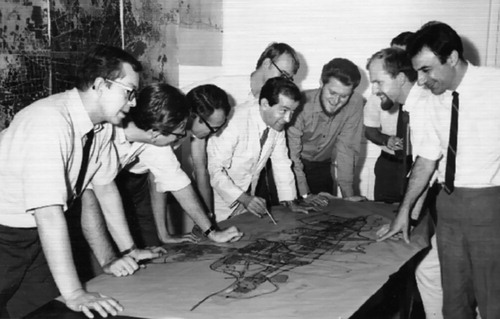
Directed with Fereydoon Ghaffari, the joint venture involved multiple local and international actors who closely collaborated to negotiate Tehran’s urban problems and plot the future of the city. Several local agencies and organizations cooperated with the planning team, namely the Plan Organization, the Ministry of Housing and Development, Ministry of Transport, the Ministry of Water and Power, Iran’s Central Bank, the Tehran Municipality, the Statistical Centre of Iran, and the newly established Social Research Institute.Footnote63 Moreover, Gaffari selected the Dutch Economic Institute as the consultant on economic issues, and the American firm of Amman and Whitney for input regarding engineering and infrastructure planning.Footnote64
The first Tehran master plan and the interplay between local and foreign planners
Prior to the establishment of the TMP, local actors and city authorities had their own development agendas emanated from the changing demographic, economic, and social structure of the city. The 1962 land reforms exerted a dramatic impact on Tehran and its pattern of population growth; the implementation of land reforms on a national scale gave rise to massive rural-urban migration, which meant that migrants were streaming into the capital.Footnote65 Many peasants who could not repay their loans to the banks were attracted by rising job opportunities in the capital.Footnote66 As a result, in the mid-1960s, Tehran’s population reached approximately 2.8 million, almost one third of Iran’s urban population.Footnote67 At that time, Tehran’s urban expansion involved ‘under-regulated, private-sector driven and speculative development’, and the Tehran municipality was not capable of controlling this process.Footnote68 By swiftly integrating surrounding towns and villages, the city was growing in a disjointed manner in all directions.Footnote69 This process transformed Tehran into ‘a number of towns connected to each other in an inappropriate way’, As Madanipour comments.Footnote70
In the mid-1960s, the historical centre of Tehran was a dominant political, economic, and administrative hub that provided infrastructure and services for an ever-increasing population.Footnote71 The concentration of power, jobs, and industries further exacerbated Tehran’s politico-economic centrality on the national scale.Footnote72 Central Tehran was becoming home to all of the headquarters of Iranian banks and insurance companies.Footnote73 This also attracted foreign firms to establish new branches in the capital.Footnote74 Tehran was becoming an international cosmopolitan city.Footnote75 All of the newly arriving services and companies accumulated in the central core to take advantage of the proximity to the other commercial and business activities located there.Footnote76
The increasing congestion of Tehran’s central district encouraged the spatial redistribution of the population which exacerbated the existing social polarization in the capital.Footnote77 Outlying residential areas were mainly expanding towards two old settlements, Shemiran in the north and Ray in the south, without being accompanied by sufficient growth of economic, social and civic facilities. In line with the development of the outer areas of Tehran and the expansion of street networks, affluent families left the congested central areas and moved to less dense places in the northern and western peripheries.Footnote78 As affluent people relocated, the deserted central areas were refilled by the urban poor and newcomers from distant cities and villages. The less privileged preferred to reside near their workplaces in the centre, both to pay less for public transportation and to benefit from low rental prices in this densely populated area where families shared spacious traditional courtyard houses.Footnote79
Apart from the rising problems in the old city centre and the necessity of its decongestion,Footnote80 the Shah personally signalled a great interest in developing modern commercial centres in the capital.Footnote81 The Shah was a progressive man who personally desired Tehran to be a modern capital like the most advanced urban developments around the world.Footnote82 He saw the new centres in part as a way of meeting Tehranis’ ravenous demand for consumption of goods and services. But more critically, he saw these new centres as powerful tools to bring about political and socio-economic changes: they offered the possibility of diminishing the dominance of the old city centre and the baazar and, in turn, the influence of traditional ruling class, the ulema and the bazaarie, who enjoyed strong control over the city centre and the Tehran bazaar. The Tehran bazaar was primarily ‘a wholesale and import-export marketplace’ involved in large-scale commerce which constantly played a crucial role in major political episodes.Footnote83 The Shah’s economic policies and the state’s focus on extensive industrialization posed a major threat to the role of the Tehran bazaar.Footnote84 Arang Keshavarzian stressed that ‘Mohammad Reza Shah was public and virulent in his disdain for bazaaris’.Footnote85 He asserted that the Shah’s opposition ‘had its roots in the modernist developmental ideology that denied the bazaar’s relevance to national and international commerce and predicted its demise’.Footnote86 In his book Answer to History, published a year after the 1979 Islamic Revolution, the Shah explained his intention of reducing the position of bazaars, notably the Tehran bazaar, in order to hasten national economic growth:
Bazaars are major social and commercial institution throughout the Mideast. But it remains my conviction that their time is past. The bazaar consists of a cluster of small shops. There is usually little sunshine or ventilation so that they are basically unhealthy environs. The bazaaris are a fanatical lot, highly resistant to change because their locations afford a lucrative monopoly. […] I could not stop building supermarkets, I wanted a modern country. Moving against the bazaars was typical of the political and social risks I had to take in my drive for modernization.Footnote87
Soon after the establishment of the TMP, the Iranian planners of the team dived into studying the changing socio-economic context of the city. Relying on the research conducted by the Social Research Institute in Tehran University and their own social surveys studying 27 different districts in the city, the planning team underlined the changing traditional habits of Iranian society.Footnote94 Based on the existing data and statistics, they mapped the location and the number of religious, cultural, recreational and market places in Tehran, and highlighted the rising tendency of families towards modern recreational facilities rather than traditional and religious urban spaces.Footnote95 The planners concluded that
As a result of diminutions of family ties and an associated increase in education, the ‘norms’ of social behaviour will rapidly change, influenced particularly by the urbanized countries. The old shopping patterns will disappear; the bazaar and the downtown centre are likely to diminish in importance, and the demand will arise for large ‘out-of-town’ centres fully equipped with parking, restaurants, supermarkets and community facilities. People will become more aware of their environment and the demand for adequate living space, public services and community facilities will increase.Footnote96
As a reaction to local realities in the capital, the planning team called for shifting the centre of attention from the old city centre, riddled as it was with socio-political and physical problems, into modern centres of activities dispersed throughout the city. They scrutinized Gruen’s original concept of future metropolis, Cellular Metropolis of Tomorrow, and rejected its centripetal form radiating from the city centre ().Footnote100 Moreover, Gruen aimed to define a workable size for his urban model and put emphasis on the magnetic power of modern centres to counterattack urban sprawl,Footnote101 although the result of shopping centres would promote further growth and accelerate the nightmare of suburban sprawl.Footnote102 Gruen argued that ‘there is a limit, somewhere, to the workable size of a metropolitan area. When the size is reached, then it would be wiser to limit further growth and to start with a new metropolitan region in another location’.Footnote103
Figure 4. The diagram shows Gruen’s concept of the metropolis of tomorrow including ten satellite towns united with a mega centre.
Source: Victor Gruen Papers, American Heritage Centre, University of Wyoming.
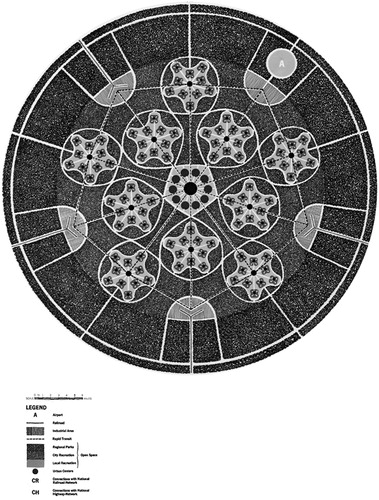
An operation was therefore needed to hybridize the Gruen’s urban model with the wider social and economic structure of the city. After finishing the data collection and the preliminary analysis of alternative urban forms (), Ghaffari asked Contini (the Victor Gruen Associates partner in charge of the Tehran project) to send an urban planner and a transportation specialist from the Los Angeles office to join the planning team for further consultations.Footnote104 On a few occasions, Contini also came to Tehran to participate in the development of the technical dimensions of the plan.Footnote105 The planning team examined the domination of the old city centre and aimed to redistribute service facilities agglomerated there among the centres of six new satellite towns positioned on an east–west axis. shows how the proposed new satellite towns were located on a linear axis running perpendicular to the existing north–south axis. Each new satellite town with a population of 300,000–500,000 would consist of communities of 20,000–30,000 people united by a new centre of activities. Each community in turn was divided into smaller units consisting of neighbourhoods of 5000 people served by smaller scale centres containing a school, a park, and neighbourhood commercial spaces. Moreover, the expansive farmlands in west Tehran were considered assets for the city’s expansion. Counting on these empty lands, the TMP almost tripled the city’s area from 180 to 600 km2, and pushed the growth of the city westward.
Figure 5. Five alternatives for Tehran’s urban pattern.
Source: Victor Gruen and Abdolaziz Farmanfarmaian, “The Comprehensive Plan of Tehran”.
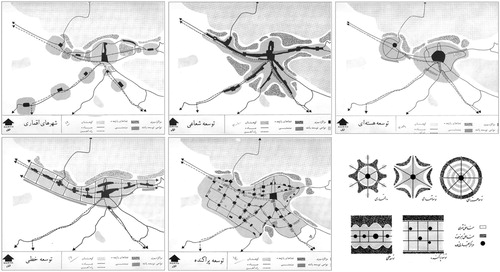
Figure 6. The diagram shows the linear urban structure for Tehran proposed by the TMP.
Source: Victor Gruen and Abdolaziz Farmanfarmaian, “The Comprehensive Plan of Tehran”.
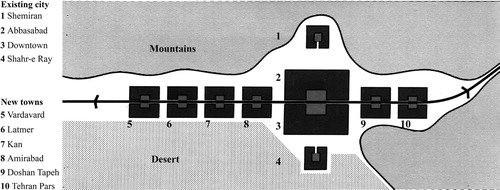
Establishing new centres of activities became the planners’ recipe for restructuring Tehran urban form ().Footnote106 To assure the realization of the proposed linear structure, the planning team relied on the magnetic attraction of multifunctional urban centres encompassing a shopping centre, trade offices, governmental buildings, recreation facilities, and hotels.Footnote107 Using the lure of ‘modern’ centres of activities, the planners attempted to guide the extension of the city beyond its existing parts. The planners saw these new centres as focal points with invaluable land to be filled with high-rise buildings (). But, the verticality of these new centres contrasted starkly with the general horizontality of the old central districts. The planning team emphasized the prompt development of Latmer, a new satellite town located at the western end of the proposed linear structure. Due to its strategic location, the planners provided detailed plans for this new satellite town. With plans for an Olympic centre, a huge recreational park, new universities, and the new extension of Mehrabad airport, the satellite town of Latmer was projected to become one of the most attractive hubs of the capital, opposing the dominance of the old centre ().Footnote108
Figure 7. The final proposal of the TMP indicates a rejection of the centripetal urban form.
Source: Victor Gruen and Abdolaziz Farmanfarmaian, “The Comprehensive Plan of Tehran”.
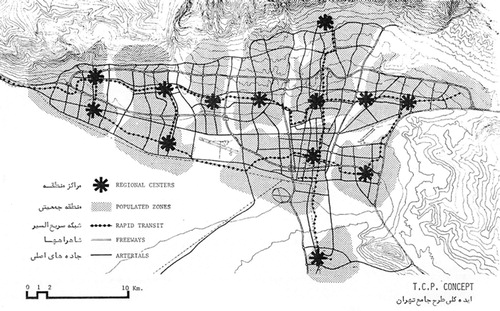
Figure 8. The Tehran Master Plan’s proposal for the new centres of activity in Tehran.
Source: Victor Gruen and Abdolaziz Farmanfarmaian, “The Comprehensive Plan of Tehran”.
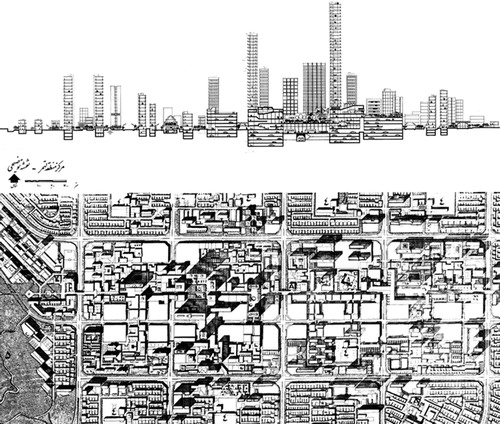
Figure 9. The sketch shows the TMP’s proposal for the development of empty stretches of land in West Tehran.
Source: Victor Gruen and Abdolaziz Farmanfarmaian, “The Comprehensive Plan of Tehran”.
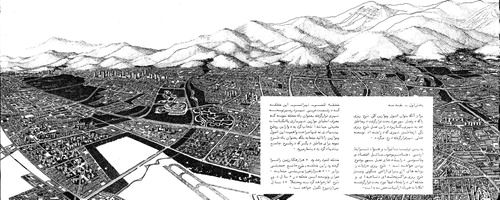
Based on a three-year close collaboration with national and international agencies and extensive research studies, the local planners prepared a number of reports in two phases. The first phase provided the socio-cultural and economic and physical analysis and recommendation for future development of the city, and the second phase provided detailed plans and specific recommendations for the realization of the TMP. In November 1968, the first phase was approved by the HCUP.Footnote109 It was at this time that Gruen travelled to Tehran for the second time to attend the presentation of the plan to the Iranian cabinet headed by the Prime Minister Amir-Abbas Hoveyda.Footnote110 The participation of Gruen as a big-name planner in this formal meeting was more symbolic to enhance the credibility of the final outcome. By the end of 1969, the second phase was completed and obtained final approval.Footnote111 The planning team also made one presentation to the Shah. But this time Gruen did not attend the meeting as he had already retired from Victor Gruen Associates.Footnote112 This time Iranian planners, Farmanfarmaian and Ghaffari, were in charge of presenting the plan to the Shah.Footnote113 The approval of the second phase came at the end of the one million dollar contract and in turn the joint venture.Footnote114 Farmanfarmaian hired some of the employees and Ghaffari returned to Victor Gruen Associates, and in 1971 he was appointed as Vice President in charge of the Planning Department.Footnote115
The 1970s economic atmosphere and the fate of the first Tehran master plan
Following sudden economic changes in the early 1970s, the Plan Organization increased the budget allocated to Tehran’s development projects and intensified efforts to implement various parts of the TMP.Footnote116 Until the early 1970s, the implementation of the TMP was largely confined to the construction of highway networks.Footnote117 The 1973 oil crisis brought about an unprecedented economic boom to Iran: the country’s oil revenues quadrupled in just a few months.
In order to guarantee the development and realization of large-scale urban projects by local architects and planners, this time the Plan Organization obliged Iranian firms to form joint ventures together instead of collaborating with foreign firms.Footnote118 It was at this time that Farmanfarmaian’s firm (AFFA) joined with Reza Majd’s office and therefore grew in size.Footnote119 AFFA became one of the biggest and busiest architectural companies in the country.Footnote120 It had almost 400 Iranian and foreign employees; approximately 150 of them were located in the Athens branch in Greece working on the International Airport project in south Tehran.Footnote121 In 1975, the AFFA was commissioned to envision detailed plans for the implementation of two new satellite towns that were integral parts of the TMP: Kan satellite town, located in northwest Tehran with a population of 283,000, was planned to accommodate government employees of high and medium income.Footnote122 Lavizan satellite town, in northeast Tehran with a population of 266,000, was designed for low-and medium-income government workers.Footnote123 indicates the location of the two satellite towns in relation to the Tehran metropolitan region. The underlying goal of the new satellite towns was to establish ‘strong regional magnets’ realizing the TMP’s concept of linear growth along an east–west axis.Footnote124
Figure 10. The map shows the location of two new satellite towns, Kan and Lavizan.
Source: Abdolaziz Farmanfarmaian and Associates, “The New City of Lavizan.”
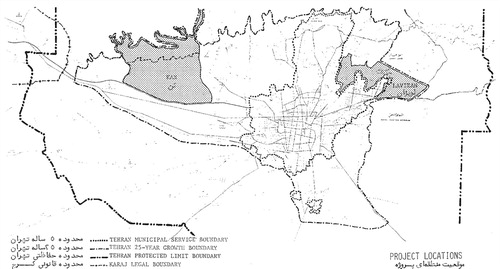
To elaborate the plan for Tehran new satellite towns, Farmanfarmaian invited Fereydoon Ghaffari, the former director of the TMP, to join the office and to establish a Planning Department leading the development of the projects.Footnote125 Ghaffari eagerly accepted the position and left Gruen Associates. This was a good time for him to make such a move. In the mid-1970s, Gruen Associates was feeling the effects of global economic crisis. While the 1973 oil crisis brought economic growth to Iran, many developed countries worldwide experienced economic downturns, particularly the United States. The U.S. federal government decided to cut off loans to developers of new towns and new community projects.Footnote126 As a result, many urban projects in the United States were halted, which had dramatic effects on American architectural and planning firms.
To establish the Planning Department in the AFFA, Ghaffari tapped the local planners and invited Iranian planners Fereydoon Rassouli and Fereshteh Bekhrad, who were among the planners involved in the TMP (). Soon after its foundation, the AFFA’s Planning Department included a staff of 20; most were Iranian architects and planners and there were a few Americans.Footnote127 As in the TMP, the basic units of neighbourhood and community provided the main structural order for all developments within Lavizan and Kan; a combination of transportation facilities, a mass transit system and a freeway network would link them to the rest of the city.Footnote128 All communities were clustered around a regional centre, comprising commercial and recreational facilities, office buildings and high-rise apartments ().Footnote129
Figure 12. The sketch shows the urban structure of the new town of Kan in West Tehran.
Source: Abdolaziz Farmanfarmaian and Associates, “The New City of Kan.”
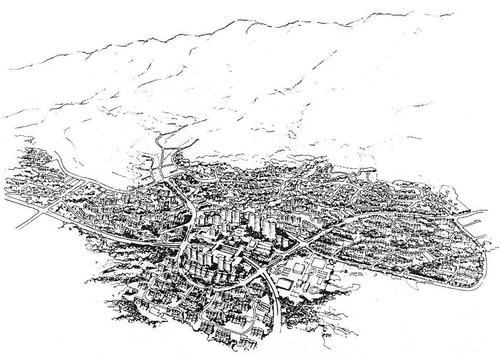
In the late 1970s, the changing social and economic condition in the capital led to a more pessimistic view on the role of modern planning in general and the efficiency of the TMP in particular. Critics contended that modern planning in Tehran failed to achieve the wholesale modernization and development of the city that it had enthusiastically claimed since the approval of the TMP in 1969.
There was a growing concern about unjust spatial development at the scale of the capital. When the Tehran Municipality began to take possession of lands for the construction of the new satellite towns of Kan and Lavizan, these districts were already occupied by squatters.Footnote130 As there was no plan to relocate those who would become homeless, the land preparation procedure provoked serious conflicts between the officials and those people. In Lavizan’s district there was a shantytown called Shemiran Nu with a population of nearly 60,000 poor and low-income people. In 1978 Tehran’s mayor, Gholamreza Nikpey, ordered its demolition. According to Rassouli, the planning head of the Lavizan project, people resisted the officials who tried to demolish their homes and set fire to Meidan Jaleh, a nearby square. The Shah’s army intervened and responded by shooting at 20,000 protesters in Jaleh square; 400–900 people were killed and nearly 4000 were wounded.Footnote131 This ‘sea of blood between the Shah and the people’ led to further protests against the Shah’s top-down modernization project and the realization of the TMP.Footnote132 Directed by ulema and bazaaries who also struggled with their own marginalization in the society, these massive protests stimulated the sparks of the 1979 Islamic Revolution.Footnote133
The late 1970s economic downturn also challenged the further realization of the TMP.Footnote134 At the time of realization of Kan and Lavizan, other large-scale urban projects in Tehran including Shahestan new centre, the new international airport, and the high-cost system of metro and expressways competed for financial resources.Footnote135 These projects magnetically attracted developers and strived for space, construction labours, and customers, and therefore left significant physical, economic and social impacts on Tehran.Footnote136 As manufacturing grew to be the most important industrial sector in the capital, the general wage index of construction workers increased threefold.Footnote137 Despite directing a considerable proportion of oil income towards manufacturing, Iran’s economy lost its earlier dynamism and faced severe stagnation.Footnote138 This affected the realization of large-scale urban projects in the capital and resulted in the halt of the ongoing projects. In that time, Tehran was littered with unfinished urban projects.
Preventing undesirable development appeared the chief weakness of modern planning and gave rise to scepticism towards the future of master planning in Iran.Footnote139 In this regard, the New York Times wrote:
With Iran’s oil boom slowing, planners and intellectuals in Tehran are voicing scepticism about the wisdom of further splurging on such urban embellishments as skyscrapers, a subway system and sewers. […] In both public and private, more and more complaints are being heard here about what is described as unlimited and ill-planned growth. These objections contrast with the planning rhetoric heard near the start of the boom in 1973, and they are paralleled by complaints elsewhere in the Persian Gulf region.Footnote140
Conclusion
Through investigating the contribution of local planners in the first Tehran Master Plan (TMP), this paper shows that the TMP as the most significant planning vision for Tehran evolved with the help of local planners while involving a wide range of actors and agencies at the international level. This paper recognizes the critical role played by Iranian planners in directing the plan and pioneering a modernist and technocratic culture of urban planning in Iran in an international context. They were architects and planners, most of whom graduated from prestigious American and European universities, who brought different perspectives to the project influenced by various countries where they completed their training. They were knowledgeable about cutting-edge foreign planning techniques as well as changing local conditions. By unravelling their transformative role in conception, formation and realization of the TMP, this paper reveals that Gruen served as a figurehead who intervened little in the actual planning process. Acknowledging Gruen’s concept of grand multifunctional centres, the Iranian planners altered Gruen’s original urban model to accommodate changing local conditions. Gruen’s model was adapted as a response to conditions in Tehran and then it was re-shaped to fit a particular conceptual, geographical and environmental framework. This paper resists the notion of blind mimicry and instead emphasizes the localization and hybridization of international planning ideals in the TMP.
Studying the TMP from the perspective of local actors clarifies how local planners shaped the nexus between indigenous and international experts and agencies. They used the TMP to form a transnational platform that helped local planners develop a modern planning regime in an Iranian context. They were optimistically hoping to create a vernacular planning regime via transnationalism, which helped institutionalize a modern planning system in a country with no long-standing tradition of planning. Transnationalism grew out of a local policy to institutionalize a modern planning regime in Iran compatible with standards of wealthy industrialized countries and local geographical, environmental and socio-economic realities, while nurturing local experts. However, in the late 1970s, the effectiveness of modern planning and its transnationalism in Iran were being challenged by local critics, and the profession of planning was demoralized. Modern planning schemes, in particular the TMP, were left vulnerable and exposed to political opposition after the 1979 Islamic Revolution and the overthrow of the Pahlavi regime. In the intense political atmosphere of the 1980s, the newly established Islamic government firmly re-linked the TMP to the goals of an autocratic ruler and therefore the TMP became a subject for wholesale change. However, the 8-year Iran-Iraq and the economic conditions of the 1980s made this goal very difficult to achieve. Unlike growing criticism of the TMP and the modern planning system in Iran, the TMP remained the principal planning document for Tehran, but indeed with deviations from its original regulatory framework.
Acknowledgements
Special thanks to the insightful comments of Dr. Dariush Borbor and Ferydoon Rassouli whose support helped us to improve this manuscript. The authors are grateful to Dr. Amy Thomas and Prof. Catherine Maumi for their comments on the earlier version of the paper. We would like to thank the anonymous reviewers for their constructive criticism.
Disclosure statement
No potential conflict of interest was reported by the author(s).
Additional information
Notes on contributors
Elmira Jafari
Elmira Jafari is an architect with diverse research and professional experience in the field of architecture and urban developments. Currently, she is a doctoral researcher at the Faculty of Architecture and the Built Environment, Delft University of Technology. Her research interests focus on transnational urbanism and the complexities of conceptualizing the cities of future, coping with changing local context and future uncertainties.
Carola Hein
Carola Hein is Professor and Chair of the History of Architecture and Urban Planning at Delft University of Technology. Her book publications include Adaptive Strategies for Water Heritage, The Routledge Handbook of Planning History, The Capital of Europe, Rebuilding Urban Japan after 1945, and Port Cities: Dynamic Landscapes and Global Networks. She currently works on the transmission of planning ideas among port cities and within landscapes of oil.
Notes
1 McLeod, National Planning in Iran, 264.
2 Gruen, The Heart of Our Cities.
3 Wakeman, Practicing Utopia, 280.
4 Khosravi, “Camp of Faith.”; Marefat, “Fractured Globalization.”; Emami, “Urbanism of Grandiosity.”; Mohajeri, “Louis Kahn’s Silent Space.”; and Khatam, “Tehran Urban Reforms.”
5 Wakeman, Practicing Utopia.
6 Ibid., 281.
7 Ibid.
8 Hardwick, “Creating a Consumer’s Century,” 401.
9 Nasr and Volait, Urbanism: Imported or Exported?
10 Ward, “Re-Examining the International Diffusion.”
11 Mashayekhi, “The 1968 Tehran.”
12 Urbanism: Imported or Exported?
13 Matin, Recasting Iranian Modernity.
14 Summitt, “For a White Revolution,” 564.
15 Shirazi, Contemporary Architecture, 18.
16 Pahlavi, Answer to History, 193.
17 Madanipour, Tehran.
18 Mashayekhi, “The 1968 Tehran,” 9.
19 Bostock and Jones, Planning and Power, 112.
20 Summitt, “For a White Revolution,” 570.
21 Nadernezhad, “Daramadi Bar,” 889.
22 Mashayekhi, “The 1968 Tehran.”
23 Nadernezhad, “Daramadi Bar.”
24 Iranica, “Abolhassan Ebtehaj.”; and Bostock and Jones, Planning and Power.
25 Farmanfarmaian, “Farmanfarmaian Az Tarhe.”
26 Nadernezhad, “Daramadi Bar.”, and Bostock and Jones, Planning and Power.
27 Sadri, Tahavolat-E Tarhrizi Shahri, 106.
28 Ibid., 107.
29 Ibid., 106.
30 Ibid.
31 Borbor.
32 Habibi.
33 U.S. Department of Commerce, Iran: A Survey, 71.
34 See: Mashayekhi, “The 1968 Tehran,” 14.
35 Karbaschi, “The Role of Decision.”
36 Borbor.
37 Organization, The Third Development Plan.
38 Sadri, Tahavolat-E Tarhrizi Shahri, 108.
39 Ibid.
40 Farmanfarmaian, “Farmanfarmaian Az Tarhe.”
41 Ghaffari, My Journey.
42 Borbor.
43 Ibid.
44 Ibid.
45 Ghaffari, My Journey.
46 Ibid., 112.
47 Ibid., 111.
48 Hajian, “Chehel Va Chahar Salegi.”
49 Hein and Sedighi, “Iran’s Global Petroleumscape.”
50 Rassouli.
51 Ibid.
52 Ibid.
53 Ghaffari, My Journey, 121.
54 Farmanfarmaian, “Farmanfarmaian Az Tarhe.”
55 Ghaffari, My Journey, 123.
56 Victor Gruen, Victor Gruen Associates.
57 “The Comprehensive Plan for Tehran.”
58 Hein, “The Exchange of Planning.”
59 Ghaffari, My Journey, 124.
60 Ibid., 125.
61 Ibid.
62 Ibid.
63 Gruen and Farmanfarmaian, “Tehran Comprehensive Plan.”
64 Ibid.
65 Matin, “Recasting Iranian Modernity.”
66 Kamali, Multiple Modernities, 217.
67 Organization, The Third Development Plan.
68 Madanipour, “Urban Planning and Development,” 435.
69 Ibid.
70 Ibid.
71 Madanipour, Tehran, 11.
72 Boroujerdi, “The Centrality of Tehran.”
73 Ibid.
74 Bahrambeygui, “Tehran: An Urban Analysis,” 108.
75 Boroujerdi, “The Centrality of Tehran.”
76 Bahrambeygui, “Tehran: An Urban Analysis,” 70.
77 Rabiei-Dastjerdi and Kazemi, “Tehran: Old and Emerging.”
78 Madanipour, Tehran.
79 Bahrambeygui, “Tehran: An Urban Analysis,” 136.
80 Amirahmadi and Kiafar, “The Transformation of Tehran.”
81 Rassouli.
82 Ibid.
83 Keshavarzian, Bazaar and State, 25.
84 Kamali, Multiple Modernities, 215.
85 Keshavarzian, Bazaar and State, 133.
86 Ibid.
87 Pahlavi, Answer to History, 156.
88 Rassouli.
89 Mohsen habibi, “As Foro Rikhtan Baroha,” 13.
90 “Nakhostin Seminar,” 189–97.
91 Ibid.
92 Hardwick, Mall Maker, 155.
93 Maumi, “L’urbanisme Tri-Dimensionnel.”
94 Gruen and Farmanfarmaian, “Tehran Comprehensive Plan.”
95 Ibid.
96 Secretariat, “An Analysis of the Tehran,” 9.
97 Ibid.
98 Sadri, Tahavolat-E Tarhrizi Shahri.
99 Secretariat, “An Analysis of the Tehran.”
100 Gruen and Farmanfarmaian, “Tehran Comprehensive Plan.”
101 Gruen, The Heart of Our Cities, 203.
102 Gruen et al., Shopping Town.
103 Gruen, The Heart of Our Cities, 283.
104 Ghaffari, My Journey, 126.
105 Ibid., 128.
106 Sennett, “Living in the Endless City.”
107 Gruen and Farmanfarmaian, “Tehran Comprehensive Plan.”
108 Ibid.
109 Secretariat, “An Analysis of the Tehran.”
110 Ghaffari, My Journey, 128.
111 Ibid.
112 Hardwick, “Creating a Consumer’s Century,” 386.
113 Ghaffari, My Journey, 128.
114 Ibid., 129.
115 Ibid.
116 Organization, The Third Development Plan.
117 Associates, “The New City of Lavizan,” 18.
118 Borbor.
119 Helgeson, Iran-U.S. Claims, 74.
120 Milani, Eminent Persians, 1, 149.
121 “Farmanfarmaian Az Tarhe.”
122 Associates, “The New City of Kan.”; and Costello, “Tehran.”
123 Associates, “The New City of Lavizan.”
124 Ibid., 28.
125 Ghaffari, My Journey.
126 Ryan, Design after Decline, 6.
127 Ghaffari, My Journey.
128 Associates, “The New City of Lavizan,” 14.
129 Ibid.
130 Rassouli.
131 Hurd, The Politics of Secularism, 112, 75.
132 Abrahamian, Iran between Two Revolutions.
133 Rassouli.
134 Mohajeri, “Louis Kahn’s Silent Space.”
135 Council, “Major Planning and Development,” 25.
136 Ibid.
137 Katouzian, The Political Economy of Modern Iran, 277.
138 Looney and Frederiksen, “The Iranian Economy.”
139 Brindley et al., Remaking Planning.
140 Pacejune, “Tehran Projects.”
141 Nasr and Volait, Urbanism: Imported or Exported?
142 Faridi, “Is There Any Future.”
143 Ibid.
144 Ibid.
Bibliography
- Abdolaziz Farmanfarmaian Associates. “The New City of Kan.” In Phase Two: Detailed Plan. The Ministry of Housing and Urban Development, 1976.
- Abdolaziz Farmanfarmaian Associates. “The New City of Lavizan.” In Phase One: Existing Condition and Conceptual Plan. The Ministry of Housing and Urban Development, 1976.
- Abrahamian, Ervand. Iran Between Two Revolutions. Princeton, NJ: Princeton University Press, 1982.
- Amirahmadi, Hooshang, and Ali Kiafar. “The Transformation of Tehran from a Garrison Town to a Primate City: A Tale of Rapid Growth and Uneven Development.” In Urban Development in the Muslim World, edited by Hooshang Amirahmadi, and Salah S. El Shakhs, 109–136. New Brunswick, NJ: Rutgers University Press, 1993.
- Bahrambeygui, Hooshang. “Tehran: An Urban Analysis.” Durham University, 1972.
- Borbor, Dariuish. Edited by Elmira Jafari, 2019.
- Borbor, Dariush. Edited by Elmira Jafari, Octobr 2019.
- Boroujerdi, Mehrzad. “The Centrality of Tehran in Iranian Sociopolitical Life.” (2015).
- Bostock, Frances, and Geoffrey Jones. Planning and Power in Iran: Ebtehaj and Economic Development under the Shah [in English]. London, England: F. Cass, 1989.
- Brindley, Tim, Yvonne Rydin, and Gerry Stoker. Remaking Planning: The Politics of Urban Change. New York: Routledge, 2005.
- Costello, Vincent Francis. “Tehran.” Chap. 290 p.: ill.; 23 cm. In Problems and Planning in Third World Cities, edited by Michael Pacione, 156–186. London: Croom Helm, 1981.
- Emami, Farshid. “Urbanism of Grandiosity: Planning a New Urban Centre for Tehran (1973–76).” International Journal of Islamic Architecture 3, no. 1 (2014): 69–102. doi: 10.1386/ijia.3.1.69_1
- Faridi, Azar. “Is There Any Future for Town Planning in Iran?” Art and Architecture 41–42 (1973): 114–119.
- Farmanfarmaian, Abdolaziz. “Farmanfarmaian Az Tarhe Jame Tehran Che Migoyad?” 18–25. Tehran: Shahrnegar, 2006.
- Farmanfarmaian, Abdolaziz. “Farmanfarmaian Az Tarhe Jame Tehran Migoyad.” Shahrnegar 36 (2006): 18–25.
- Ghaffari, Fereydoon. My Journey: From Anzali to Los Angeles. Middletown, CT: CreateSpace Independent Publishing Platform, 2018.
- Gruen, Victor. The Heart of Our Cities: The Urban Crisis: Diagnosis and Cure [in English]. London: Thames and Hudson, 1964.
- Gruen, Victor, Anette Baldauf, and Michael Stephen Gruen, eds. Shopping Town: Designing the City in Suburban America. 1 Online Resource Vols. Minneapolis: Univ Of Minnesota Press, 2017.
- Gruen, Victor, and Abdolaziz Farmanfarmaian. Tehran Comprehensive Plan, Tehran: The Plan Organization, 1966–1969.
- Habibi, Seyed Mohsen. Edited by Elmira Jafari, 2019.
- Hajian, Babak. “Chehel Va Chahar Salegi-E Tasvib-E Avalin Tarh-E Jam-E Tehran.” Donyay-e Eghtesad (2008): 1507.
- Hardwick, M. Jeff. “Creating a Consumer’s Century: Urbanism and Architect Victor Gruen, 1938–1968.” 2000.
- Hardwick, M. Jeffrey. Mall Maker: Victor Gruen, Architect of an American Dream [in English]. Philadelphia: University of Pennsylvania Press, 2004.
- Hein, Carola. “The Exchange of Planning Ideas from Europe to the USA After the Second World War: Introductory Thoughts and a Call for Further Research.” Planning Perspectives 29, no. 2 (2014): 143–151. doi: 10.1080/02665433.2014.886522
- Hein, Carola, and Mohamad Sedighi. “Iran’s Global Petroleumscape: The Role of Oil in Shaping Khuzestan and Tehran.” Architectural Theory Review 21, no. 3 (2016): 349–374. doi: 10.1080/13264826.2018.1379110
- Helgeson, Edward, ed. Iran-U.S. Claims Tribunal Reports. Vol. 31. Cambridge: Cambridge University Press, 1995.
- Hurd, Elizabeth Shakman. The Politics of Secularism in International Relations. Vol. 112. Princeton, NJ: Princeton University Press, 2009.
- Iranica, Encyclopaedia. “Abolhassan Ebtehaj.”.
- Kamali, Masoud. Multiple Modernities, Civil Society and Islam: The Case of Iran and Turky. Liverpool: Liverpool University Press, 2006.
- Karbaschi, Gholam Hossein. “The Role of Decision Making Processes in Urban Management Systems (Case Study of Tehran).” PhD diss., Newcastle University, 2013.
- Katouzian, Homa. The Political Economy of Modern Iran: Despotism and Pseudo-Modernism, 1926–1979 [in English]. London: Macmillan, 1981.
- Keshavarzian, Arang. Bazaar and State in Iran: The Politics of the Tehran Marketplace. Cambridge: Cambridge University Press, 2007.
- Khatam, Azam. “Tehran Urban Reforms Between Two Revolutions Developmentalism, Worlding Urbanism and Neoliberalism.” PhD diss., York University, 2015.
- Khosravi, Hamed. “Camp of Faith: On Political Theology and Urban Form.” 2014.
- Looney, Robert E., and P. C. Frederiksen. “The Iranian Economy in the 1970s: Examination of the Nugent Thesis.” Middle Eastern Studies 24, no. 4 (1988): 490–494. doi: 10.1080/00263208808700759
- Madanipour, Ali. Tehran: The Making of a Metropolis, 1998.
- Madanipour, Ali. Urban Planning and Development in Tehran. Elsevier, 2006.
- Marefat, Mina. “Fractured Globalization: A Case Study of Tehran.” In New Global History and the City, edited by Elliott R. Morss, 1–17. Newton Centre, MA: New Global History Press, 2004.
- Mashayekhi, Azadeh. “The 1968 Tehran Master Plan and the Politics of Planning Development in Iran (1945–1979).” Planning Perspectives 34, no. 5 (2019): 849–876. doi: 10.1080/02665433.2018.1468805
- Matin, Kamran. Recasting Iranian Modernity: International Relations and Social Change. Hoboken: Taylor and Francis, 2013.
- Maumi, Catherine. “L’urbanisme Tri-Dimensionnel De Victor Gruen À L’épreuve Du ‘Futur Prévisible’.” Paper presented at the Invent the Greater Paris, 1944–1960s, 2015.
- McLeod, Thos H. National Planning in Iran: A Report Based on the Experiences of the Harvard Advisory Group in Iran [in English]. Regina: Sask, 1964.
- Milani, Abbas. Eminent Persians: The Men and Women Who Made Modern Iran, 1941–1979: In Two Volumes. Vol. 1. New York: Syracuse University Press, 2008.
- Mohajeri, Shima. “Louis Kahn’s Silent Space of Critique in Tehran, 1973–74.” Journal of the Society of Architectural Historians. 74, no. 4 (2015): 485–504. doi: 10.1525/jsah.2015.74.4.485
- Mohsen habibi, Zahra Ahari, Rashid Emami. “As Foro Rikhtan Baroha Ta Andishehe Shahrha.” Soffeh Journal 50, no. 20 (2009): 51–61.
- Nadernezhad, Parvane. “Daramadi Bar Faaliatha-E Sazman-E Barname Dar Zaman-E Riasat-E Abolhassan Ebtehaj.” Payame Baharestan 16 (2012): 882–907.
- Nadernezhad, Parvane. “Nakhostin Seminar Barresi-E Masael-E Ejtemaei Shahr-E Tehran 1341.” 1964.
- Nasr, Jose, and Mercedes Volait, eds. Urbanism: Imported or Exported? Chichester: Wiley-Academy, 2003.
- Pacejune, Eric. “Tehran Projects Face Challenges.” New York Times, June 6, 1976.
- Pahlavi, Mohammad Reza. Answer to History. [in English] 1st Scarborough books ed. New York: Stein and Day, 1982.
- Rabiei-Dastjerdi, Hamidreza, and Maryam Kazemi. “Tehran: Old and Emerging Spatial Divides.” In Urban Change in Iran: Stories of Rooted Histories and Ever-Accelerating Developments, edited by Fatemeh Farnaz Arefian and Seyed Hossein Iradj Moeini, 171–186. Heidelberg: Springer, 2016.
- Rassouli, Fereydoon. Edited by Elmira Jafari, 2019.
- Ryan, Brent D. Design After Decline: How America Rebuilds Shrinking Cities. Philadelphia: University of Pennsylvania Press, 2012.
- Sadri, Bahram Farivar. Tahavolat-E Tarhrizi Shahri Iran Dar Dorane Moaser. [in Persian] [Contemporary Urban Planning Changes in Iran]. Tehran: Iranian Society of Consulting Engineers, 2014.
- Sennett, Richard. “Boundaries and Borders.” In Living in the Endless City: The Urban Age Project by the London School of Economics and Deutsche Bank’s Alfred Herrhausen Society, edited by Deyan Sudjic and Richard Burdett, 324–332. London: Phaidon Press Ltd, 2011.
- Shirazi, M. Reza. Contemporary Architecture and Urbanism in Iran: Tradition, Modernity, and the Production of ‘Space-in-Between’. [in English]. Cham, Switzerland: Springer, 2018.
- Summitt, April R. “For a White Revolution: John F. Kennedy and the Shah of Iran.” The Middle East Journal 58, no. 4 (2004): 560–575. doi: 10.3751/58.4.12
- Tehran Development Council Secretariat. “An Analysis of the Tehran Comprehensive Plan.” In Technical Report, No. 1. Tehran: Tehran Development Council. Secretariat., 1976.
- Tehran Development Council Secretariat. Major Planning and Development Issues Affecting Tehran’s Future: An Interim Report to the Tehran Development Council. Tehran: The Secretariat, 1976.
- The Plan Organization, The Plan. The Fith National Development Plan, 1973–1978.
- The Plan Organization. The Third Development Plan, 1962–1968.
- U.S. Department of Commerce, Domestic and International Business Administration, Bureau of International Commerce. Iran: A Survey of U.S. Business Opportunities. 1977.
- Victor Gruen, Associates. Victor Gruen Associates: Architecture, Planning, Engineering. [in English] [Los Angeles, Calif.?]: Victor Gruen Associates, 1966.
- Wakeman, Rosemary. Practicing Utopia: An Intellectual History of the New Town Movement. Chicago: University of Chicago Press, 2016.
- Ward, Stephen V. “Re-Examining the International Diffusion of Planning.” In Urban Planning in a Changing World: The Twentieth Century Experience, edited by Robert Freestone, London: Routledge, 2012.

